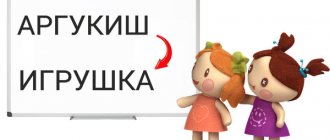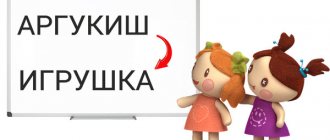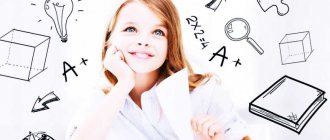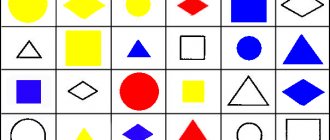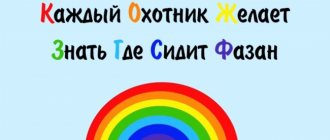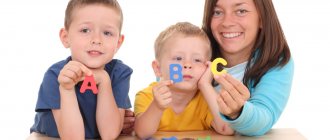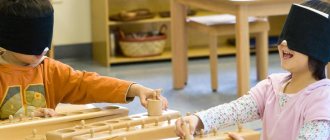Auditory memory is one of the types of figurative memory, thanks to which we capture auditory images, store them and reproduce them.
In preschool age, involuntary memory predominates in children, in which everything that is bright, emotional, interesting, and unusual is remembered “by itself,” without the participation of will and consciousness. Voluntary memory will have to be developed, and this cannot be achieved without some effort. You can read more about voluntary and involuntary memory in our article Involuntary memory and voluntary memory
A developed auditory memory will be the key to a child’s mastery of correct pronunciation of words, intonation of sentences, expressive reading, and spelling. Impaired auditory memory can become a stumbling block when studying the school curriculum, because oral explanations are an important part of mastering the material.
The auditory type of memory, like other types of memory, involves processing information by the brain: its transformation and storage. In the process of listening, sound stimuli are converted into nerve impulses, transmitted to the brain along the auditory nerve, perceived and processed by the brain; The process also includes conscious perception of sounds.
The correct perception of information depends on the ability to determine the source, highlight the main sounds, recognize them, and fill in the missing ones. An error at any stage will fail and lead to incorrect processing of what is heard.
Using various simple tests, you can get an idea of the state of children’s auditory memory, and through games and exercises, you can improve its volume.
If a child fails to complete a test task or exercise, it’s okay. Try to explain differently or explain again. Even if you are irritated or upset, do not show this to your baby. You must be a support and support for him. Many problems and complexes of adults come from childhood, and they are born, among other things, from the fear of being or looking bad, stupid, worse than everyone else, that is, from self-doubt due to the negative reaction of adults, whose opinion the child values. But praising a child for his achievements, even if they are small, is useful. Don't compare him with other children, rather celebrate his own small victories. If you notice that your child is having difficulty constructing sentences correctly, do not be upset or upset the child, but do not delay consultation with a specialist (speech pathologist-speech pathologist).
Auditory memory disorders
It happens that a child experiences difficulties in perceiving speech, when isolating it from the surrounding noise, cannot immediately understand tasks and commands received orally, when mastering new words or learning languages. These problems may not be related to attention deficits or lack of motivation, and may not be the result of bad behavior. Perhaps the reason lies in auditory neurological disorders. Disorders of auditory processing may be associated with traumatic brain injury, long-term inflammation of the middle ear, birth trauma, and other causes. In such cases, consultation with a specialist is necessary. Treatment, as a rule, includes several areas: improving cognitive and speech skills, improving the perception of auditory information, improving the quality of the auditory signal.
"Word Catcher"
Not to be confused with "dream catcher")
You will need:
- Pre-prepared story.
Let's take an example right away.
In the text below you need to “catch” (hear and remember) all the words that denote furniture.
My mother and I decided to re-wallpaper a small room. But first it was necessary to clear the room of furniture. We called Uncle Seryozha and Uncle Pasha from neighboring apartments for help. They tried to remove the bed for a very long time, as it turned out to be very heavy. The men were very tired, but still managed. And then they set to work at the desk.
Mom and I weren’t idle either. They took out the chairs and rolled out a bedside table on wheels. There was only a closet left in the room. It turned out to be so huge that it did not fit through the doors. How did he even get here? Unclear. It was decided to move the closet to the middle of the room so that it would not interfere with our wallpapering.
Procedure:
- You ask to listen carefully to the text and remember all the words that refer to furniture.
- Reading the text.
- Find out what the child heard and remembered.
Three to five words are enough. Texts may be different. If this is a text about a forest, then we look for the names of animals, if about a school, then the names of schoolchildren, if about lunch, then the names of dishes, etc.
Diagnostics of auditory memory
There are various methods for diagnosing auditory memory that make it possible to accurately determine its condition at the everyday level.
“10 Words” Methodology by A.R. Luria
This technique is often used as a rapid diagnosis of auditory memory. The results obtained make it possible to assess the level of development of auditory memory, auditory attention, fatigue, and the level of phonemic hearing. This auditory memory test is used both for children of middle preschool age and for adults.
Prepare words in advance, for example: table, hare, mirror, tree, wall, fly, feather, star, bird, notebook. Ask your child to listen and memorize this series, and then read the words at intervals of 1-2 seconds. Let him reproduce all the words that he managed to remember.
Repeat reading and playing three times, record those words that were memorized. For the fourth time, the child must remember and repeat all the words in random order after 20-30 minutes.
Results: if a child remembers 4-6 words after the first reading, this is a normal result. If you remember less, but other words were included in the answer, perhaps there is a low level of auditory attention.
If you remember less, but replace some sounds, your phonemic perception may be impaired.
The second and third reproduction after reading is an indicator of the child’s memorization speed and fatigue.
The fourth reproduction is an indicator of the volume and level of development of long-term memory. The norm is if the child can reproduce two words more or less than the best result after the first three attempts.
A simplified version of the Luria Auditory Memory Test
Repeat a series of 10 words up to 7 times until either the subject remembers all the words, or a decision is made to interrupt the auditory memory test.
It is considered normal if a person remembers at least 5 words after the first reading. By the fifth repetition, all 10 words should be memorized.
Diagnostics of RAM (Wechsler “Counting” subtest)
Stage 1: the subject is given 3 numbers and asked to repeat them, then 4 numbers, then five, etc., and so on until the first error.
Stage 2: the same task (repeat the named numbers), but only “back to front”, starting with the last one, that is, in reverse order.
The norm is to memorize 5-9 digits when counting forward and at least 5 when counting backwards.
"Remember two-digit numbers"
This method of diagnosing auditory memory is suitable for children of middle and high school age and for adults.
Prepare 12 two-digit numbers. For example, a set of numbers could be: 22, 17, 43, 21, 14, 49, 56, 71, 86, 15, 61, 76.
Warn your child that he will need to listen and remember the numbers, and then, after the signal, write down all the numbers that he can remember, in random order, for 30 seconds. Results: the result is considered good if the subject remembers 7 numbers.
Diagnostics of auditory memory using literary texts
In order to test auditory memory, you need to select a short plot text consisting of 10 - 12 simple sentences. This could be, for example, a short story, a fairy tale, a fable for children, and a more complex informative story for adults. The text is read legibly, not too quickly, expressively. Then it is played back to the subject for the first time immediately after listening, and again an hour after that. The norm is the correct presentation of the plot and 1-2 errors on the first playback, and up to 3-4 errors on the second.
There are other, more complex tests that examine auditory and other types of memory, but their use requires the skills and knowledge of psychologists to examine and interpret the results in more detail. Such tests are usually carried out in specialized institutions.
"Planet of Robots"
Another drawing exercise.
You will need:
- Paper.
- Pencil.
- Pre-prepared text.
The text could look like this.
Our spaceship has safely reached the planet of robots. When we went down the ramp, we were met by three local residents - robots. One of them was very tall, he had an elongated rectangular body and a triangular head. The eyes looked like two squares, and the mouth looked like a thin strip. Instead of arms and legs there are springs.
The second robot was short with a square body and head. Large round eyes looked at us with curiosity, and the triangular mouth broke into a smile. The handles looked like thin sticks. The legs were also very thin and it was not clear how they could support such a heavy body.
The third robot was the most beautiful. It had a small oval body and a round head, from which protruded three straight antennae with silver balls at the ends. He kept batting his rectangular eyes and opening his round mouth wide. Instead of legs, it had a caterpillar, like a tractor. And the hands resembled two semicircles.
Procedure:
- Ask your young student to listen carefully to the text.
- Read the text.
- Give your child a piece of paper and a pencil.
- Ask them to draw a second robot.
- Read the text again and check that you completed the task correctly.
This exercise can be made more difficult by asking you to draw not just one robot, but two. You can add colors to the description. That is, the eyes will be not just square, but also red, and the body will be rectangular and blue.
Exercises to develop auditory memory
A child cannot do without the help of adults for the successful development of auditory memory. Reading poems, proverbs and sayings aloud clearly, slowly and expressively, or listening to age-appropriate audiobooks is a good step in this direction. And if a child retells the passage read after ten minutes of reading, this will already be a real exercise for the development of the child’s auditory memory. Even just when dressing your child, accompany your actions with words. This way the baby will learn to compare sounds and actions.
Exercises for kids should be turned into games, because this is how children most willingly absorb new knowledge.
— Game “10 pairs”
This game helps improve concentration and auditory memory. Come up with 10 pairs of words that are related in meaning in advance. For example: shoes - laces, telephone - beep, rain - cloud, plum - compote, pen - notebook, orange - lemon, candy - cookies, bear - den, hedgehog - needles, house - roof. Read them to your child three times, take your time, speak expressively, emotionally, with intonation. And for the fourth time, read only the first words, and let the child remember and name the second word or pair for each of them.
— Game “Do as I do”
You will need: paper; two glasses, one of which is filled with water; 2 spoons; hammer; bell. Ask your child to close his eyes. After this, perform 3-4 sound actions with the prepared objects. For example, pour water from glass to glass several times; clink the spoons together; stir the water in the glass with one of the spoons; rustle the paper, tap the spoon on an empty or full glass.
After this, ask the child to open his eyes, remember the sounds and repeat them from memory.
- Game “Guess what it was?”
Prepare several recordings (for example, use a voice recorder or find suitable recordings on the Internet). For example, this could be the sound of the wind, the roar of the surf, the crackling of wood in a fire, the singing of birds, the sound of rain, the sound of thunder, the sound of applause, the rustling of a wrapper when unwrapping candy, the crunch of crackers, and so on. Ask your child to guess what it was. Ask him to try to repeat it, play with him, make digressions from the game, telling something interesting about these sounds and phenomena.
— Game “Remember and complete”
This game will help increase your auditory memory. The presenter can start, for example, like this: “I put a book in my briefcase.” The second player must repeat this phrase and add his word. For example, like this: “I put a book and a flashlight in my briefcase.” Each time the next player must repeat everything that was named before him and add his own word. If there are many players, the one who gets confused leaves the game, and if there are few, he gets one point. If you score three points, you become an observer. Start options may vary. For example:
“Today I saw outside the window...”;
“My friend has in his room...”
“Behind a high fence they kept...”
“Masha had in her basket...”
- Variant of the same game:
Begin any sentence. For example: “Masha went out into the clearing and saw...” Let the child repeat what he heard and continue. For example: “Masha went out into the clearing and saw a small hut...”. Then follow the same principle: the next player repeats and complements. For example: “Masha went out into the clearing and saw a small hut with strawberries growing around it...”. Keep memorizing and composing until someone fails. This game also helps to increase the volume of auditory memory, but, in addition, develops imagination.
— Game “Feel the Rhythm”
Tap a simple rhythm with your fingertips or the back of a pencil and ask your child to repeat it. Alternatively, you can tap out the rhythm by clapping your palms.
— Game “Guess the ending”
This exercise for developing auditory memory is intended primarily for preschool children. Read short children's poems to your child, but do not say the last word. Let the child guess and name it himself. This is very useful, because the child will have to use vocabulary, rely on logic, take into account rhythm and consonance (rhyme).
More tips and exercises for developing auditory memory can be found in our article Auditory Memory. Development of auditory memory. And the game “Zvukvar”, the link to which you will find here, is intended specifically for training auditory memory.
Memory develops best if it is frequently used and stimulated. More information about short-term memory and its development can be read in our article Short-term memory - what is it? How to develop short-term memory? In addition, you can develop memory in different ways. It is very convenient to use memory training exercises for this purpose.
We wish you pleasant caring for your child and, of course, success in self-development!
"Snowball"
This exercise is familiar to many. But probably not everyone. So I’ll tell you a little about him.
There are many exercise options. Let's, for example, let's get ready for vacation and put things in a suitcase.
I say: “I have a swimsuit in my suitcase.”
You say: “I have a swimsuit and a towel in my suitcase.”
Me again: “I have a swimsuit, a towel and a Panama hat in my suitcase.”
You: “I have a swimsuit, a towel, a Panama hat and flip-flops in my suitcase.”
And so on. There are more and more words, like snow in a snowball. They must be memorized and reproduced every time. Very useful fun.
Moreover, you can choose the topic to your taste. For example, “we’re making soup,” and we start with the words: “I have in a saucepan...”. Or “we’re opening a zoo.” Here everything is limited only by your imagination.
Wait, who's coming? It's me, your attention
Attention is a cognitive process by which a child or adult makes a choice of what to perceive, remember, and therefore store, recall and use in relation to information, activity, and communication.
The child is under a very large flow of impressions and images, but only what comes into the area of attention can enter consciousness and be remembered. Weak memory equals weak attention.
People with high intelligence have a high ability to concentrate and regulate their attention. Their memory is full of knowledge, since their attention ensures that the necessary information is received and remembered.
Conversely, a person with poor attention has insufficient knowledge and constantly lacks it. Attention is the bottleneck through which information enters and is remembered.
You can check your attention here (opens in a new tab), and the student’s attention here.
The most important type of attention to develop
This, of course, is voluntary attention. What do you need to know about its development in a child?
From birth, the child has direct and involuntary attention.
By the end of the first year of life, the prerequisites for the future development of voluntary attention appear, he begins not only to react, but also to do something independently at will, he directs his activity to what interests him.
He tries to do something, take it out, examine it, taste it, throw it, throw it away)
At 2-3 years of life , reactive voluntary attention develops, arising under the influence of an adult’s speech, his facial expressions, gestures, as well as under the influence of the direction of the child’s gaze at the named object.
The child himself begins to use these means to attract other people.
4.5-5 years is the beginning of active voluntary and mediated attention. A child can direct his attention to some object when an adult draws his attention to it, under the influence of complex speech instructions.
The child begins to control his own attention (drawings, signs).
By the age of 5-6 years, under the influence of independent instructions, the child develops elementary forms of voluntary attention; he can describe what he is doing out loud, and this speech guides his attention.
It has a small volume and is not yet quite unstable.
Junior schoolchildren. At this age, further development of voluntary and indirect attention occurs. But it lags behind the attention of an adult in all respects: stability, distribution, concentration, switchability and volume.
Only by adolescence does the level of development of attention reach that of an adult.
In games we will develop just these properties of attention:
- stability - the ability to remain at a certain level for a long time
- distribution - the ability to split into several tasks at once
- concentration - the ability to concentrate on one thing, thought, image and distract attention from everything else
- switchability - switching from one object to another (speed or speed)
- volume - the maximum number of objects held simultaneously

